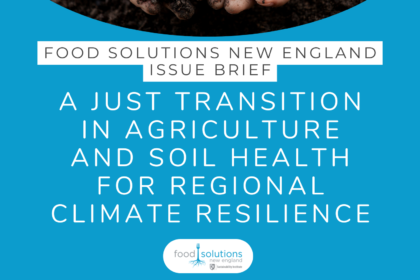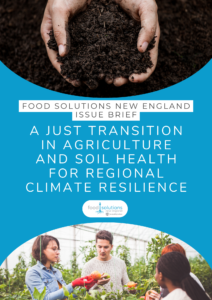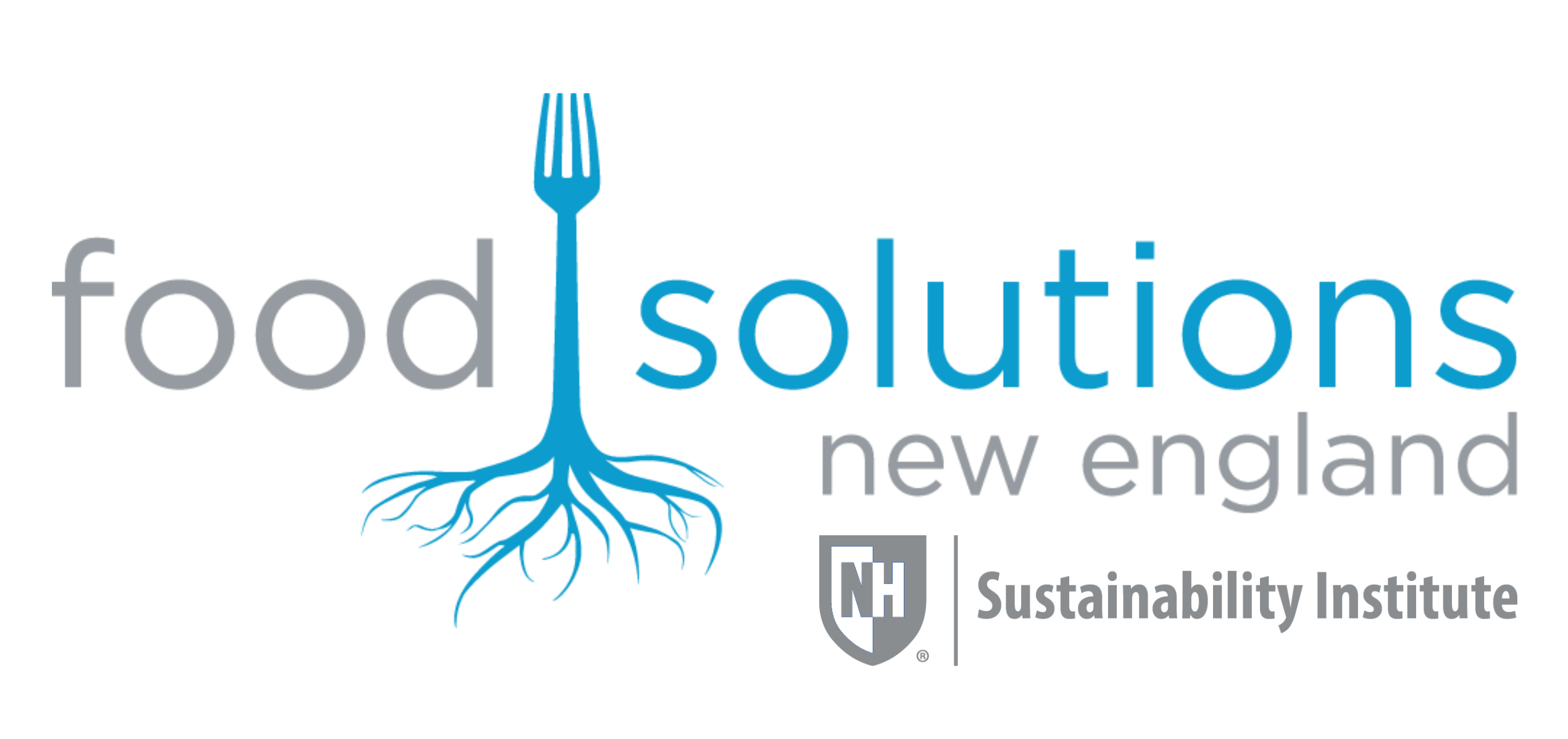
 This issue brief is part of Food Solutions New England’s Campaign for Climate Resilience. The purpose of this campaign is to advocate for community-led solutions to create a climate-resilient food system that is equitable and in which ownership of food production and distribution are decentralized and democratic.
This issue brief is part of Food Solutions New England’s Campaign for Climate Resilience. The purpose of this campaign is to advocate for community-led solutions to create a climate-resilient food system that is equitable and in which ownership of food production and distribution are decentralized and democratic.
This issue brief will focus on a Just Transition in agriculture and how its pursuit can build soil health and how building soil health can support a Just Transition.
Click here to download a PDF version of the issue brief
Defining a Just Transition in New England Agriculture
From community work to state and federal level advocacy, a Just Transition “focuses on the values, agency, relations and processes that underlie both structures and systems” and “create the capacities that empower individuals and communities to take action on their own behalf.”¹ A Just Transition puts governance, power, and democracy at the center and acknowledges that sustainability transitions, especially in agriculture, will only be addressed by shifts in political-economic power.
Domains of a Just Transition include access to natural ecosystems, knowledge, networks, systems of exchange, gender and equity.² When analyzing work toward a Just Transition, the question must be asked: Whose knowledge is considered valid, and is therefore enabled and valued, through contemporary modes of knowledge production and mobilization? The social dynamics of marginalization and inequality pose a major barrier to the development of sustainable food systems in this regard. When all types of knowledge are valued, including community, indigenous, and practitioner, then community voices are lifted up to create solutions for their own needs and overturn inequities across the food system.
Thus, the starting point is to expand networks through participatory governance to identify and respond to community needs and flex the “democracy muscle.” In other words, true change towards climate resilience through agriculture is only going to come when community leadership and decision-making at all levels of governance are understood and centered – a task that will require a wholesale mindset shift.
Soil Health and a Just Transition
Many believe soil health is solely a biophysical issue. But in pursuit of a Just Transition, there is much that can be learned by looking at the similarities between the processes of building soil health and creating more equitable societies. Firstly, the same systems that caused the problem cannot serve as a solution to the problem they created. A new paradigm to build soil, protect the environment, and to move toward a Just Transition are desperately needed.
In How to Be a Soilkeeper, Kiley Arroyo, executive director of the Cultural Strategies Council, an organization committed to justice-centered transformation through interdisciplinary research and collaborative learning states, “Soil fertility, like justice, is a dynamic condition that enables life to thrive over time. Maintaining both requires a diverse web of entities to continually recalibrate how they behave in step with shifting circumstances and led by those most impacted by those changes.”³
To be successful in repairing the harm done to both the soil and social fabric of communities, there must be support for a diversity of solutions. This can allow “coordinated ecosystems of actions” that are contextually relevant to flourish. Whether it be policies, supply chains, markets, farm management of soil, or a whole host of other intersecting work, centering the needs of the community is the first and necessary step. “Living systems use a set of time-tested principles to share power and collectively maintain fertile conditions in which life can flourish. Healthy ecosystems demonstrate the kind of actors, distinct roles, relationships, exchanges, structures, and behaviors that enable systems to transform to support the vitality of the whole. All of this activity rests upon the fulcrum of soil.”⁴
Building a Just Transition Through Soil Health in Boston
Communities that are networked build soil health. The Boston Food Forest Coalition (BFFC) is one such collaborative group that is working to establish more just food communities while simultaneously building healthy soils.
At the intersection of racial equity and climate resilience, the BFFC is a community of neighbors transforming vacant lots into public edible parks placed into permanent community control and ownership. Food forests are majority-perennial gardens planted with fruit and nut trees, berry bushes, herbs, and other edible plants. Designed to be public resources, BFFC’s food forests offer spaces for neighbors to gather, connect with one another and the natural world, grow healthy food, and step into climate leadership and collaborative land care. When neighbors know each other and are invested in the health of local public land, they’re better able to problem-solve and create solutions for a healthier, more equitable and more resilient future.
Each BFFC food forest project is initiated and led by community members who are intimately familiar with the needs of their neighborhoods. They collaboratively participate in the planting of the site, its maintenance over time, and the transformation of the space into a beloved resource in the community. These neighbors also sit on BFFC’s Board of Directors, governing the land trust itself, and actively participate in a cross-Boston network of land stewards that share resources and knowledge. This process (of building food forests and integrating them into the broader network) simultaneously increases soil health through the regenerative power of trees and plants cultivated at each site and through the networked communities that lead these projects.
Boston’s history of inequitable distribution of green space has resulted in the burden of climate-induced impacts being distributed inequitably across Boston (including drought and flooding due to poor soil quality). BFFC follows community leadership and responds to local demand for food forests in neighborhoods that have been historically under-resourced with green infrastructure, supporting neighbors who are most impacted by climate change and most intimately aware of the ecological and social benefits that public green space would offer their communities. BFFC’s model aims to encourage diversity of solutions (each park with a slightly different approach to land and soil stewardship) and the centering of community leadership and collective power over traditional capitalistic productivity.
As these food forests become beloved community resources, they remain cared for over time by the neighbors of the spaces. In return, communities are strengthened by these spaces that offer fresh food grown in healthy soil and a public place to connect with nature and other people. The reciprocity between healthy soils and the networked communities that build healthy soil is ongoing — the success of one is the success of the other. Thus, resilience is built into communities both socially and ecologically, which matters tremendously as we need both to step into the reality of our climate future together.
Groups that have faced ongoing and systematic forms of aggressive marginalization and separation from land and food system control are able to better understand how to build and work within networks, even more so than privileged societies that are able to use their resources to support individual benefit. Therefore, it’s essential to move beyond privileged networks toward networks that are inclusive of all individuals and non-humans, equitable in their focus and activities, and engaging in a Just Transition in agriculture.
Policy Steps Toward a Just Transition in Agriculture and Soil Health
Policy is a tangible avenue for pursuing this work. By coming together across sectors to advance policies that recognize the interconnectedness of soil, conservation, food, energy, agriculture, coastal, and climate issues communities can support a Just Transition. While there is already progress being made in New England, there is a need to do more.
One such step could be building upon and bringing the ideas of Act 154: Vermont’s Environmental Justice law, to other states throughout New England. Act 154 actively addresses fair and equitable treatment of all individuals, access to environmental services, fair distribution of environmental burdens, and purposeful participation in democratic decision-making processes that involve the development, implementation, and regulation of environmental policies. Throughout New England there is room to be more intentional in efforts to link environmental justice to building healthy soil, conserving land equitably, and human, food, and climate justice in general. This integrated approach will support the health and wellbeing of all of New England’s residents and contribute to the health of the soil and environment. By building equitable access to socio-economic and political power, communities can drive our food and agriculture systems toward a state of health and wellbeing that supports people and the planet alike.
Federally, the Farm Bill, which is set to be passed in September of 2023, is ripe for ensuring the integration of cross-sector issues. Currently there are many coalitions working to advance similar priorities while also advancing marker bills in support of New England’s small- and medium-scale farmers and fishers. Partners like the National Family Farm Coalition and the Northeast Organic Farming Association chapters are working diligently to build support for the Justice for Black Farmers Act, the Fairness for Small-Scale Farmers and Ranchers Act, the Farmland for Farmers Act, and the Fair Credit for Farmers Act. In parallel, another partner, North American Marine Alliance, is organizing to leverage broad support for New England’s fisheries through the Improving ARCTIC Act. It “ensures major resources go to enhance local and regional seafood supply chains (both wild-caught and mariculture) and that we prohibit factory fish farms in federal waters.”⁵
These policies could be key drivers in the region’s capacity to advance a Just Transition. It’s this type of cross-sector, community-first approach, including a focus on seacoasts and seafood, that will create the opportunities for a Just Transition to be realized and to see the benefits that will follow, including building healthy soil and communities. These policy prescriptions are one important piece of the work that must be done and by organizing around a shared vision and values of a Just Transition in New England Agriculture and soil health, communities can, together, build a sustainable, resilient, and just food system.
As stated in the beginning, a Just Transition “focuses on the values, agency, relations and processes that underlie both structures and systems” and “create the capacities that empower individuals and communities to take action on their own behalf.”⁶
- ¹Scoones et al., 2020
- ²Anderson et al. 2019
- ³https://www.giarts.org/article/how-be-soil-keeper
- ⁴https://www.giarts.org/article/how-be-soil-keeper
- ⁵ Niaz Dorry, NFFC/NAMA, Personal Communication
- ⁶ Scoones et al., 2020
_____
Endnotes
- Scoones, I., Stirling, A., Abrol, D., Atela, J., Charli-Joseph, L., Eakin, H., Ely, A., Olsson, P., Pereira, L., Priya, R., van Zwanenberg, P., & Yang, L. (2020). Transformations to sustainability: Combining structural, systemic and enabling approaches. Current Opinion in Environmental Sustainability, 42, 65–75. https://doi.org/10.1016/j.cosust.2019.12.004
- Anderson, C. R., Bruil, J., Chappell, M. J., Kiss, C., & Pimbert, M. P. (2019). From Transition to Domains of Transformation: Getting to Sustainable and Just Food Systems through Agroecology. Sustainability, 11(19), Article 19. https://doi.org/10.3390/su11195272
- How to Be a Soil Keeper. (n.d.). Grantmakers in the Arts. Retrieved June 28, 2023, from https://www.giarts.org/article/how-be-soil-keeper
Authors and Acknowledgements
- Lead Authors: Julie Snorek, Northeast Healthy Soil Network, Dartmouth College; Julie Davenson, Northeast Healthy Soil Network, NOFA-NH
- Contributing Authors: Hope Kelley, Boston Food Forest Coalition; Karen Nordstrom, Food Solutions New England; Shane Rogers, Food Solutions New England
- Acknowledgement: We would like to acknowledge all participants who attended the 3rd NEHSN Symposiumheld March 16-17, 2023, at the University of New Hampshire. The knowledge co-created and mobilized through the event informed the content of this brief.




